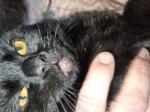Is a Big, Beautiful Birman Cat Right for You?
The Birman cat breed is an old breed considered sacred by some, but is perfectly happy being a house cat. They are playful, curious, and affectionate like their Siamese cousins. But they are more laid back, like their Persian cousins.
Would you like to spend time with a cat that is considered to be a sacred animal? Many people think that the beautiful Birman breed originated from cats that guarded the Burman temples.

This breed is even rumored to have helped the Burmese monks fight off attackers.
During that time, as the story goes, a Birman's coat turned the golden color of the goddess the monks worshiped, except for his paws which stayed pure white.
Of course, less fanciful cat lovers say the Birman is simply a French relative of the Himalayan cat breed.
Although no one is completely sure where the Birman breed came from, all cat fanciers agree that it is definitely an older breed. Some breeders say the Birman is closely related to the Siamese cat, since it resembles a slightly stockier Siamese in appearance.
In fact, more than one person has said that when the pure white Burman temple cats changed color, it was probably because a stray Siamese cat fathered a few litters of kittens.
In the nineteen twenties, the Birman cat reached Europe. A single female survived the long voyage from Burma to France and gave birth to a female kitten who is the ancestor of today's Birman cats. This cat was most likely crossed with a Siamese cat.
After World War II, the Birman was in grave danger of extinction, as only one known pair of Birmans had survived the German occupation. The breed was again outcrossed with another cat to avoid extinction, although this time the Persian was most likely used.
With all of the inbreeding that was done to save the Birman breed, it would be no surprise if these cats were prone to several hereditary diseases. However, the breed is surprisingly healthy overall.
You should be aware that most of the members of the Birman cat breed are prone to anesthesia sensitivity. Add this to the fact that Birmans can be either A or B blood type, and this can mean trouble on the operating table. The breed is also prone to developing hairballs.
Since Birmans are prone to hairballs, you may want to feed your cat a diet that is formulated to aid in hairball prevention. If he becomes lethargic and does not eat as much as he normally does, you should consult your veterinarian about treating him for hairballs.
Since this breed is not as active as some other breeds, they may have a tendency to become overweight. You may want to ask your veterinarian about feeding your cat a weight control diet if she becomes overweight.
Be aware, though, that many commercial cat foods that are supposedly for weight control may actually make your cat fatter. The best remedy is lots of play and activities for your cat throughout her life. A cat tree and a great set of cat toys are the way to go.
While this breed is a longhair breed, it does not have a heavy coat. As long as you comb your Birman's hair once a week, you should not have a problem with the coat matting. Hairball control is another matter, and more frequent grooming can go a long way in helping with that problem.
These cats are still somewhat playful, curious and affectionate, like their Siamese relatives, but are more laid back and relaxed than the Siamese, like their Persian relatives.
If you are looking for a cat that isn't quite as demanding and attention seeking as some of the more affectionate breeds, but also isn't too standoffish, the Birman cat breed is a good choice.



Comments: What do you think?
Have your say about what you just read. Leave me a comment in the box below.